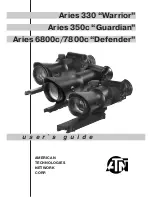
6
Focusing the Telescope
Insert the low-power 25mm eyepiece into the focuser and
secure with the thumb screw. Move the telescope so the front
(open) end is pointing in the general direction of an object at
least 1/4-mile away. Now, with your fingers, slowly rotate one
of the focusing knobs until the object comes into sharp focus.
Go a little bit beyond sharp focus until the image just starts
to blur again, then reverse the rotation of the knob, just to
make sure you’ve hit the exact focus point.
If you have trouble focusing, rotate the focus knob so the draw-
tube is in as far as it will go. Now look through the eyepiece
while slowly rotating the focus knob in the opposite direction.
You should soon see the point at which focus is reached.
The black nylon thumb screw on the top of the body of the
focuser is to lock the focuser drawtube in place once the tel-
escope is properly focused. Before refocusing, remember to
first loosen the thumb screw.
Do You Wear Eyeglasses?
If you wear eyeglasses, you may be able to keep them on
while you observe, if your eyepieces have enough “eye relief”
to allow you to see the whole field of view. You can try this by
looking through the eyepiece first with your glasses on and
then with them off, and see if the glasses restrict the view to
only a portion of the full field. If they do, you can easily
observe with your glasses off by just refocusing the telescope
the needed amount.
Aligning the Finder Scope
The finder scope must be aligned accurately with the tele-
scope for proper use. To align it, first aim the main telescope
in the general direction of an object at least 1/4-mile away—
the top of a telephone pole, a chimney, etc. Position that
object in the center of the telescope’s eyepiece.
Now, look in the finder scope. Is the object visible? Ideally, it will
be somewhere in the field of view. If it is not, some coarse adjust-
ments of the six finder scope alignment thumb screws will be
needed to get the finder scope roughly parallel to the main tube.
NOTE: The image in both the finder scope and the main tele-
scope will appear upside-down (rotated 180°). This is normal for
finder scopes and reflector telescopes (see Figure 3).
By loosening one alignment screw and tightening another, you
change the line of sight of the finder scope. The round, knurled
lock nuts installed on the alignment screws must be adequately
loosened to allow the screws to be threaded in or out. Continue
making adjustments to the alignment screws until the image in
both the finder scope and the telescope’s eyepiece is exactly
centered. Check the alignment by moving the telescope to
another object and fixing the finder scope’s crosshairs on the
exact point you want to look at. Then look through the tele-
scope’s eyepiece to see if that point is centered in the field of
view. If it is, the job is done. If not, make the necessary adjust-
ments until the two images match up. Once the finder scope is
aligned, turn the lock nuts clockwise until finger-tight to secure
the adjustment screws in place.
The finder scope alignment needs to be checked before every
observing session. This can easily be done at night, before
viewing through the telescope. Choose any bright star or plan-
et, center the object in the telescope eyepiece, and then adjust
the finder scope’s alignment screws until the star or planet is
also centered on the finder’s crosshairs. The finder scope is
an invaluable tool for locating objects in the night sky; its usage
for this purpose will be discussed later, in detail.
Focusing the Finder Scope
If, when looking through the finder scope, the images appear
somewhat out of focus, you will need to refocus the finder scope
for your eyes. Loosen the lock ring located behind the objective
lens cell on the body of the finder scope (see Figure 4). Back the
lock ring off by a few turns, for now. Refocus the finder scope on
a distant object by threading the objective lens cell in or out on
the finder scope body. Precise focusing will be achieved by focus-
ing the finder scope on a bright star. Once the image appears
Naked-eye view
View through finder scope and telescope
Figure 3. The view through a standard finder scope and reflector
telescope is upside down. This is true for the SkyView Deluxe 6" and
its finder scope as well.
Lock
ring
Figure 4. Finder scope and bracket for the SkyView Deluxe 6" EQ.
























